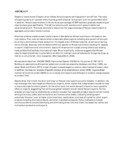| dc.description.abstract | Despite a recent boost of export price indices, Kenya’s exports earnings growth are still low. The value of exports grew by 9.1 percent while imports growth stood at 16.6 percent over the period 2005/2012. In addition, Kenya’s exports share in the world as a percentage of GDP has been gradually weakening as imports share grew significantly. This left the economy with a wide current account deficit and constrained growth. This study attempts to determine the responsiveness of Kenya’s exports (both at aggregate and product levels) to prices.
Empirical evidence explains export performance in Sub-Saharan African countries on the basis on two main factors. First, external factors which unfavorably affect exports including slow growth of demand for primary commodities (these account for the largest share of African exports), as well as worsening terms of trade. Secondly, internal factors which are specific to African economies including the capacity to export (macroeconomic environment, status of infrastructure in place among others) and existing trade policies that facilitate international trade. More importantly, evidence suggests that African exports respond positively to price falls in an effort to maintain revenue balance for foreign earnings, so that for a unit price fall, more is supplied, (Morrissey&Mold, 2006). We use panel data from UNCOMTRADE; Harmonized System HS1992 for the period of 1997-2010. Building on assumptions of imperfect substitute’s model developed by Goldstein and Khan (1985); we adopt Mold and Prizzon (2010) model of export analysis based on volume index instead of export value. In addition, we base our analysis of specific product price elasticities on Jones (2008). A generalized method of moments model (GMM) is run to study total exports and OLS used to conduct a deep analysis at product level.
Results show that in both the short and long-run Kenyan total exports are price inelastic. In addition, the real exchange rate has a negative influence on exports, which implies that a depreciation would not lead to improved exports volume growth. On the other hand, the world demand is found to have a positive effect on exports, suggesting that continuous global recession would reduce Kenya’s exports. Further analyses on exports price elasticities by products revealed that vegetable product exports (which include among others tea, coffee and horticulture) are however price elastic; indicating existing export potentials. However, even at higher price incentives, results show a net lose of market for other export products including chemical products, and other manufactured goods. Policy implications include continuous efforts towards identifying and eliminating all barriers that hinder increased tea, coffee and horticulture production and exports. | en_US |

